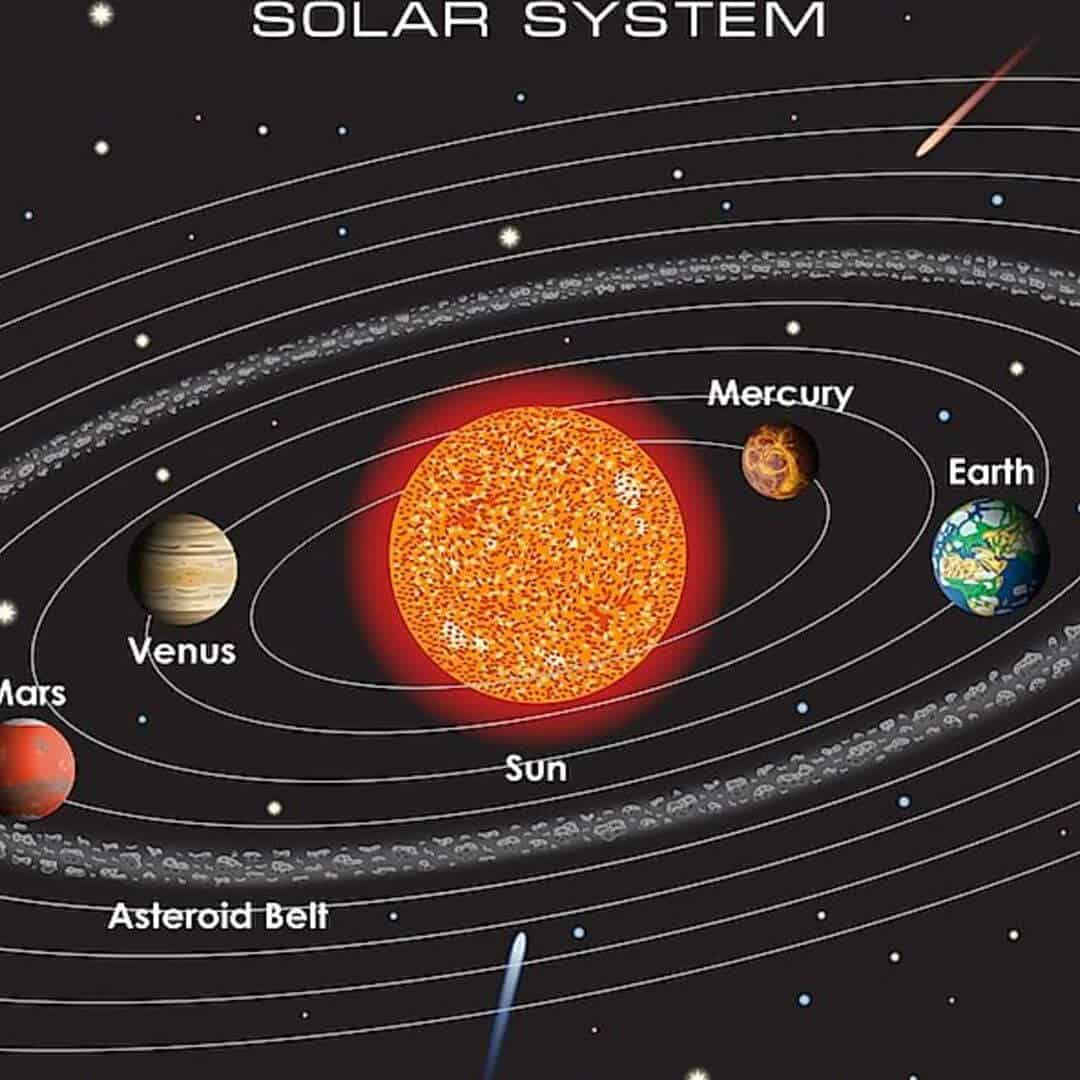Over countless centuries, the gravitational pull compressed the fundamental components of Earth, the third planet from the Sun, which came into existence 4.6 billion years ago. Its formation remains an ongoing process. Presently, the inner structure of the planet and its delicate outer layer are in perpetual motion, causing alterations in the configuration of landmasses, topography, and weather patterns.
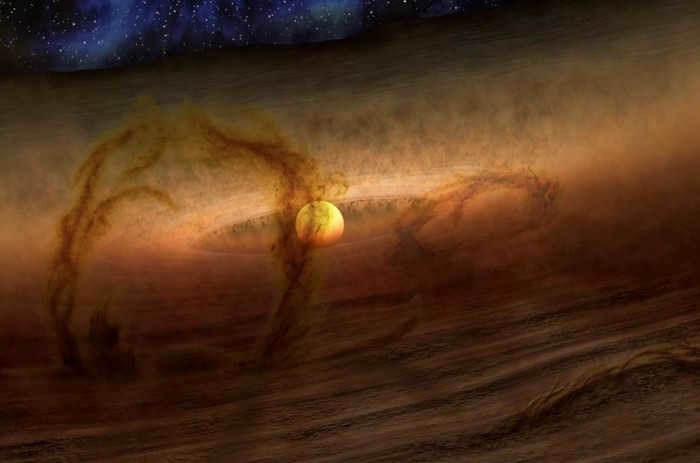
The Formation of Earth and its Composition (4.6 billion years ago)
The debris of previous stars formed the nebula from which Earth originated. This nebula consisted of tiny particles of ice, iron, and other substances that accumulated in the cooler layers of stars and were expelled into space. The particles in the gas disk were brought together and fused through the force of gravity. This process is known as accretion.
The geological history of our planet is documented in rocks, but even the oldest rocks are only 3.7 billion years old. Therefore, earlier events in Earth’s evolution can only be inferred through indirect evidence and hypotheses based on such evidence.
During the next stage of planet formation, small particles came together to form large “building blocks” known as planetesimals, which collided and then either collapsed or merged. As a result, over a span of 5-4.6 billion years ago, the nucleus – the core of what would become planet Earth – began to form.
The largest of these embryos started competing with each other for the remaining free planetesimals. This competition took place over a period of 1-10 million years. The planetary embryos in the inner part of the solar system absorbed gas clouds and merged with each other. The formation process for each planet was unique, which explains their diversity.
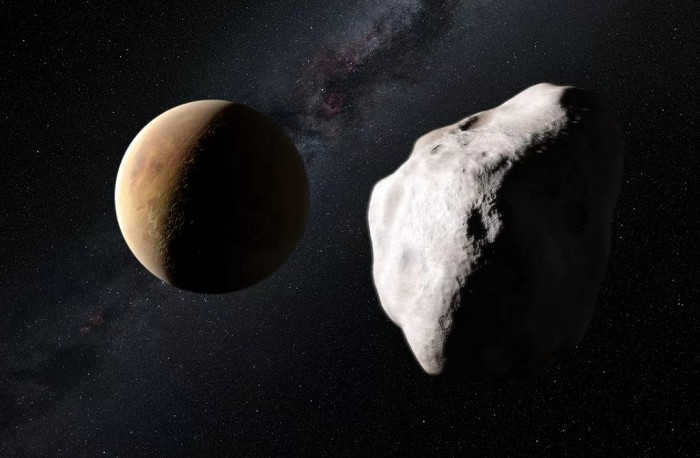
After colliding with each other, some planetesimals, such as asteroids, served as the foundation for future planets.
According to modern science, the Earth was formed approximately 300-400 million years ago. This formation process was characterized by turbulence and involved collisions with asteroids and meteorite impacts.
Similar to a giant centrifuge, denser substances sank towards the center of the planet, while lighter ones rose to the surface. The Earth’s evolution continued after its formation. The combination of particle aggregation and nuclear reactions generated two types of energy, which heated up the interior of the young planet. Consequently, the core and inner layers of the Earth began to form rapidly.
The planet’s inner layers were incredibly hot, with a molten rock layer just a few tens of kilometers below the surface. Since the Earth’s formation, there has been a continuous exchange of substance and energy between the interior, surface, and atmosphere, laying the groundwork for the emergence of life.
The early phase of the planet’s life, known as the pregeologic period, lasted for 0.9 billion years and remains largely unexplored, holding numerous enigmas. During this time, numerous volcanoes emerged, releasing gases and water vapor into the atmosphere.
There are two theories surrounding the origin of the Earth’s core. The first suggests that the Earth’s original composition separated into a dense core, composed of molten iron, surrounded by a lighter mantle made of silicates. The core formed as heavy metals and other compounds gradually sank towards the center of the planet, while lighter materials rose to the surface. These lighter materials now make up the planet’s crust and the outer portion of the mantle. However, this explanation fails to provide a satisfactory answer as to how the molten iron-nickel alloy could have penetrated over a thousand kilometers deep into the Earth and reached its core.
Supporters of the second theory argue that the Earth’s iron core is composed of remnants from iron meteorites that collided with the planet shortly after its formation. These meteorites were subsequently covered by a layer of stone (silicate) meteorites, which eventually formed the mantle. However, this hypothesis is vulnerable because it assumes that iron and stone meteorites existed separately and fell to Earth in a specific order. Research indicates that iron-structured meteorites can only form as a result of the destruction of a pre-existing planet, making them unlikely to be younger than other planets in the solar system. Therefore, neither hypothesis is entirely convincing, and it must be acknowledged that our understanding of the origin of the Earth’s core is still incomplete.
The dense core located in the center of the Earth plays a crucial role in supporting life on our planet. It is responsible for providing enough gravitational force to hold the atmospheric gases, including water vapor, in the Earth’s gravitational field. Without this core, the existence of the hydrosphere and other layers of the Earth would be impossible. Losing the core would result in the depletion of water and air, leaving us without these essential elements for survival.
How is the organization of the Earth’s core, which is said to have formed at the very beginning of the planet’s existence? The core is comprised of both outer and inner shells. It is thought that the outer layer is located between 2900-5100 km beneath the Earth’s surface and possesses physical properties that are similar to those of a liquid. This layer consists of flowing molten iron and nickel and exhibits excellent conductivity for electric current. It is thanks to this layer that our planet has a magnetic field, which is generated by the principles of electromagnetic induction through a continuously moving current conductor.
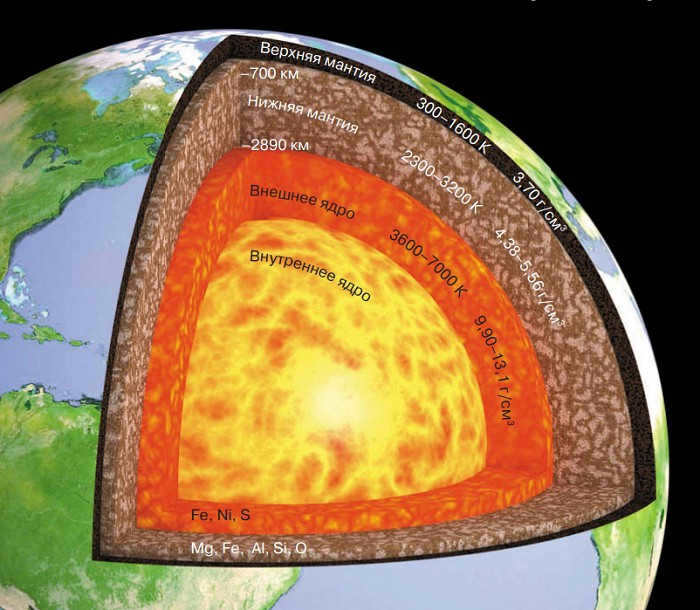
The inner core, which comprises 4/5 iron and 1/5 silicon dioxide, spans a distance of 1270 km from the Earth’s outer layer to its center. This region is characterized by extremely high temperatures and densities. While the outer core is connected to the Earth’s mantle, the inner core exists independently. The combination of high temperatures and immense pressure, reaching up to 3 million atmospheres, keeps the inner core in a solid state. It is even speculated that hydrogen, the lightest of Earth’s gases, could exist in a solid form under such extreme conditions.
The origin and internal structure of the Earth’s core remain enigmatic to scientists, with many aspects still unidentified. It is generally agreed upon that the formation of the central shell coincided with the birth of the Earth itself.
The core is enveloped by the mantle, which is composed of a plastic, semi-molten substance. This material fills the space between the Earth’s crust and the center of the planet, extending to a depth of 2900 km. The mantle accounts for approximately 67% of the Earth’s total mass. Due to its plastic nature, this layer is considered to be unstable and in constant motion. At greater depths, where the pressure is higher, the mantle transitions into a solid state. Surrounding the mantle is the Earth’s outer shell, known as the crust, which varies in thickness from a few kilometers beneath the ocean floor to several tens of kilometers beneath the continents.
In the early stages of Earth’s formation, the crust was thin and composed of solidified molten basalt. Currently, the crust can be divided into three layers: sedimentary, granite, and the deepest layer, basalt. While geologists have thoroughly explored the first two layers, the third layer remains unseen. The basalt layer is not exposed on the continents, and its great depth makes it impossible to access even with advanced drilling technology.
Nevertheless, we have some information about it due to advanced seismic techniques. Seismic waves, known as waves that happen during earthquakes, can be found at depths ranging from 10 to 700 kilometers. Similar to any type of wave, their velocity is greater in denser mediums (for instance, sound waves travel 4.5 times faster in water compared to air). By examining the speed of seismic waves, scientists can infer the density of substances at various depths in the Earth’s crust.
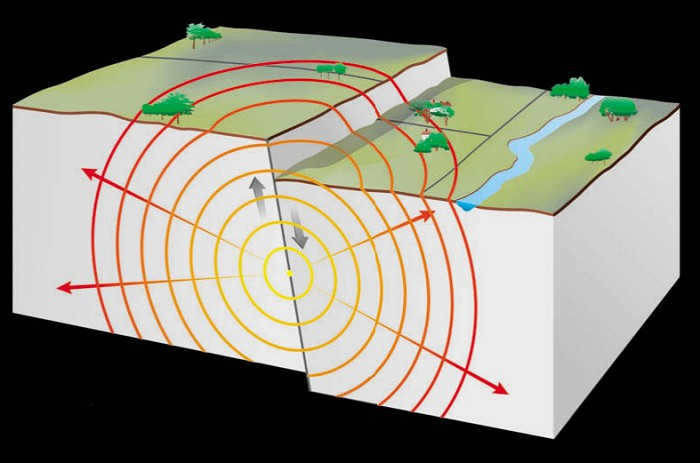
What led to the formation of the basalt layer in the Earth’s crust? In the early stages of our planet’s existence, approximately 4-4.5 billion years ago, the Earth experienced extreme heat. Within the upper mantle, there was a slight decrease in pressure, allowing certain substances to transition from a solid to a liquid state. Consequently, magma with a similar composition to basalt was generated. This magma gradually ascended towards the Earth’s surface, and upon eruption, underwent a cooling process, ultimately solidifying. Thus, the crust composed of basalt gradually emerged.
When discussing the composition of the Earth, we frequently refer to “rocks”. It is believed that Russian scientist Vasily Mikhailovich Severgin first coined the term in the late 18th century to describe various groups of minerals. During that time, the study of rocks was primarily associated with mining, hence the use of the term “mountain”, although rocks can be found in various locations, not just mountains.
Rocks can be classified into three primary types: igneous, sedimentary, and metamorphic. The origin of the first type is quite evident: these rocks are formed from solidified magma. They possess a distinct crystalline structure, and the larger crystals are a result of slower cooling of volcanic lava. Examples of such rocks include granites and basalts.
Sedimentary rocks are formed from fragments of crystalline minerals, known as fragmentary materials (such as sand, river pebbles, or tiny clay particles), as well as from the remains of living organisms, known as organic materials (such as coal, limestone with seashell fragments, and oil). When minerals undergo significant physical and chemical changes due to high temperatures and pressure, they transform into metamorphic rocks.
Both igneous and sedimentary rocks have the potential to undergo metamorphism. Shales are a common type of metamorphic rock derived from igneous rocks, while marble is a well-known example of metamorphic rock formed from limestone.
Metamorphic gneisses are among the most abundant rocks in the Earth’s crust.
The Formation of Earth’s Ancient Surface and the Origin of the Moon (4.6-4 Billion Years Ago)
During the initial stages of Earth’s formation (approximately 4.6-4 billion years ago), the Earth’s inner matter underwent a process of stratification, which was accompanied by a high level of meteorite bombardment on the planet’s surface. These meteorites impacted the Earth, creating craters. The immense energy from these impacts, following the law of conservation, transformed into heat, causing the Earth’s surface and interior to heat up. At the same time, there was a constant eruption of numerous volcanoes. Vapors and gases were released from the depths of the planet.
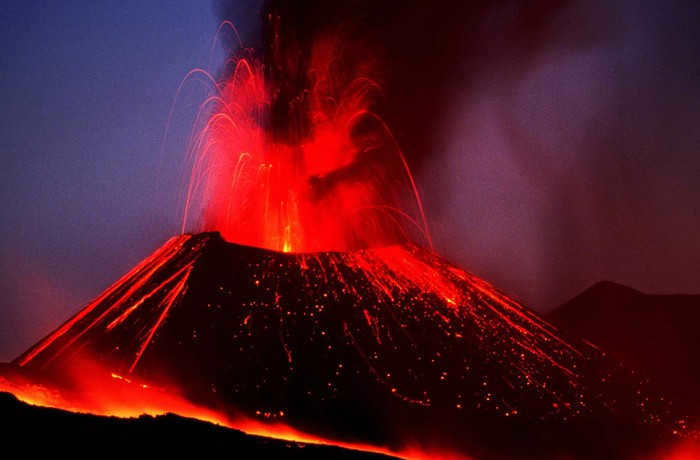
Magma, hot and molten, burst forth from deep within the Earth, blanketing large expanses of the youthful planet and giving rise to expansive basaltic fields – during this time, the Earth’s surface resembled that of the moon.
Gradually, the Earth’s internal composition evolved, aligning itself with the current scientific framework. The core, mantle, and crust underwent multiple transformations before settling into their present-day configuration.
The Moon surpasses all other satellites in the solar system in terms of its size relative to that of the Earth. This is what sets the Moon apart from the other planetary satellites. Its enigma has long puzzled scientists in their quest for answers. The most widely accepted hypothesis is that the Moon originated from a massive collision between celestial bodies. We will discuss the specifics of this cosmic catastrophe and its implications for Earth’s history at a later time.
The Moon differs from our planet in several ways. It lacks water on its surface, a lunar atmosphere, and contains very little iron and volatile compounds. However, both the Earth and the Moon share a similar ratio of oxygen isotopes, also known as the oxygen signature. This data leads to the hypothesis that both celestial bodies were formed from the same planetesimals, or “building blocks,” at a similar distance from the Sun.
The presence of a large satellite like the Moon explains various phenomena on Earth. Despite its relative proximity in cosmic terms, the Moon’s gravity has a significant impact on our planet. It not only causes tides in the oceans but also affects closed bodies of water within the Earth’s crust.
The gravitational force of the Moon creates waves that ripple across the Earth’s surface, causing it to be pulled approximately 50 centimeters towards the lunar satellite.
The colossal cosmic disaster and bombardment by meteors
Scientists Donald Davis and William Hartmann proposed the cosmic catastrophe theory to explain the formation of the Moon. According to this hypothesis, the early Earth collided with a planet the size of present-day Mars, known as Theia. The name Theia comes from the Greek mythology, where it refers to the mother of the sun god (Helios), the dawn goddess (Eos), and the moon goddess (Selene).
It is believed that Theia formed around 4.6 billion years ago, alongside the other planets in the solar system, and initially orbited the Earth. However, gravitational interactions with the Sun and Earth caused its orbit to destabilize, resulting in a collision with the Earth.
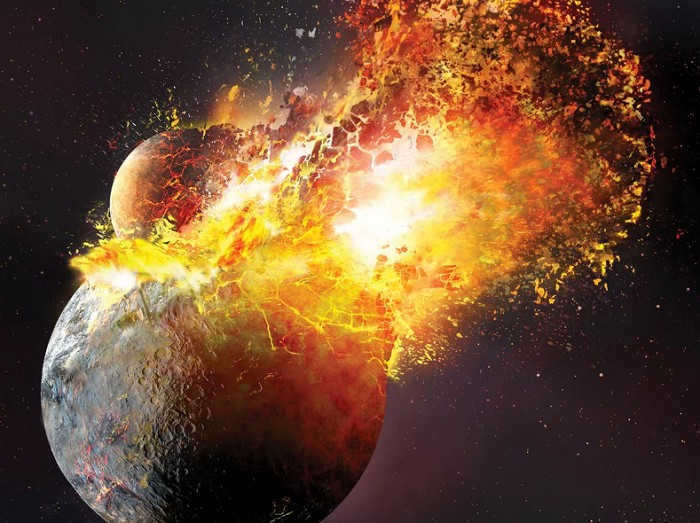
The collision took place at a relatively slow speed and at an almost tangential angle – fortunately, the planets remained intact and only a portion of the Earth and Thea’s material was ejected into space. These fragments that fell into the Earth’s orbit eventually formed the Moon, which began to orbit the Earth. As a result of the collision, the Earth experienced an increase in its rotational speed (day-night cycle) and a change in its axial tilt.
Computer simulations have supported the plausibility of such a sequence of events and have suggested that it took the Moon approximately one hundred years – a mere moment in cosmic terms – to take on its spherical shape after the collision. The relatively low iron content found in our planet’s satellite can be attributed to the fact that the collision occurred after the formation of the Earth’s core, which absorbed most of its iron.
Asteroid fragments, drifting in space, remnants of planetesimals that failed to form into planets – all this space debris rained down on the Earth and the Moon in the form of meteorites. It is believed that during the first 700 million years of existence, our planet attracted more meteorites than its satellite due to its greater mass.
Subsequent geological events have obscured evidence of past cosmic assaults. The Moon, as well as other planets like Mars and Mercury, still bear the scars of impacts – craters. These can range from massive, resembling vast seas spanning thousands of kilometers, to minuscule in size. The Earth too experienced bombardment by meteorites of various sizes during its early days.
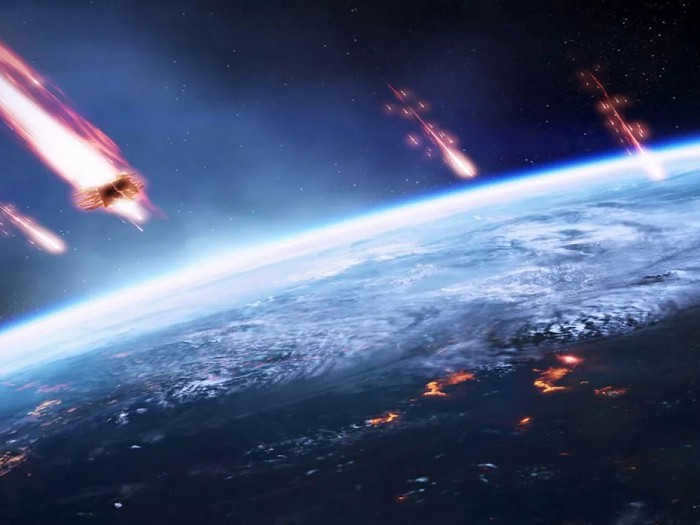
During a span of more than 100 million years, approximately 3 x 10^22 kilograms of extraterrestrial matter descended upon our planet’s surface. This staggering amount is equivalent to the weight of a freight train consisting of 500,000,000,000,000,000,000,000,000,000,000,000,000 fully loaded cars! As these meteorites made contact with Earth, their kinetic energy transformed into thermal energy, causing them to break apart and explode. This process resulted in the heating of the Earth, the release of gases, and the mixing of their composition with that of our planet.
The intense heat from this cosmic bombardment caused the young Earth’s outer layer to partially melt. However, the subsequent colossal volcanic eruptions effectively erased any remnants of this celestial assault.
There have been over 160 discoveries of meteorite craters on Earth’s surface. These craters are typically found in clusters within meteor shower zones that span tens of square kilometers. A meteor shower occurs when numerous fragments of a single large meteorite descend onto the Earth.
In these instances, rather than a solitary indentation, a collection of craters emerges, with the direction of the craters potentially revealing the trajectory taken by the debris as it entered the atmosphere.
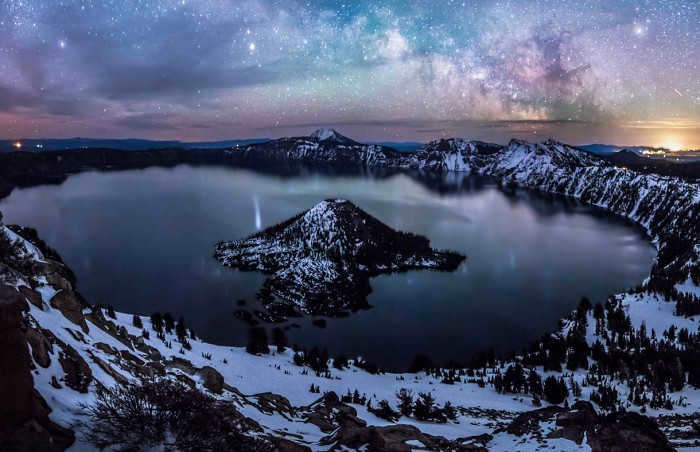
Typically, craters have a circular shape and measure approximately 100 kilometers in diameter. They are surrounded by raised embankments along the edges.
Meteorites continue to reach the Earth to this day. On February 15, 2013, fragments of a shattered asteroid fell from space onto the city of Chelyabinsk in Russia. There are a total of 16 large craters in this state, all of which have been proven to have a meteoritic origin. Satellite imagery is used to identify these craters.
Meteorites are categorized based on their composition into three types: iron, stone, and a combination of the two (iron-stone). Iron meteorites always contain nickel, and analyzing the amount of nickel in a found stone helps determine its extraterrestrial origin.
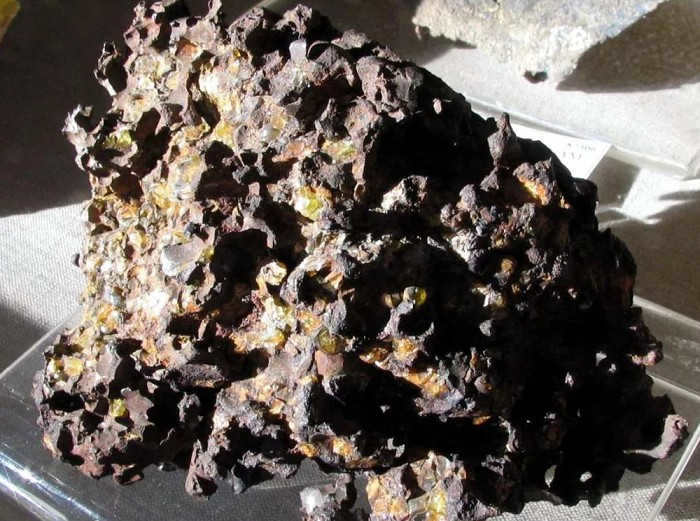
There is a specialized committee within the Russian Academy of Sciences that is dedicated to the exploration and examination of meteorites. Over the course of many years, this committee has amassed one of the most exceptional collections of celestial stones in the world, with its origins dating back to the 18th century. Meteorites can be found in various cities across Russia, and are often displayed in local historical and geological museums.
For millions upon millions of years, meteorite impacts have not only heated up the Earth’s interior, but have also altered its physical appearance. It is even possible that these celestial rocks played a role in the processes that transformed the Earth’s early atmosphere into one capable of supporting life. As a meteorite enters the dense layers of the atmosphere at incredible speeds, it becomes heated and ignites, releasing water vapor and carbon dioxide – both common byproducts of combustion reactions.
When a meteorite enters the Earth’s atmosphere, it releases approximately 12% of its mass as water vapor and 6% as carbon dioxide, totaling about 18% – nearly a fifth. If we consider a hypothetical massive train filled with meteoric material that crashed onto the planet shortly after its formation, the amount of gases released would be equivalent to filling 90,000,000,000,000,000,000,000,000,000,000,000,000,000,000,000,000,000,000,000,000,000,000,000,000,000,000,000,000,000,000,000 cars. This immense quantity of new gases introduced by meteorites altered the primordial atmosphere, enriching it with substances that eventually became the building blocks for life on Earth.
Antarctica is known as one of the prime locations for collecting and researching meteorites. The barren icy deserts of this continent offer a unique environment where the majority of the stones found are believed to have fallen from the sky. The study of these extraterrestrial rocks plays a crucial role in expanding our understanding of the cosmos, prompting the development of sophisticated robotic vehicles designed to explore the vast Antarctic expanse in search of these celestial treasures.
Conditions for Future Life on Earth: Atmosphere and Hydrosphere (4.3-3.8 billion years ago)
In the early stages of Earth’s development, the basaltic layer of the planet’s crust was formed deep within its interior, and molten magma ascended along crustal faults. This magma contained various gases. Under high temperatures and pressures, numerous chemical reactions took place, resulting in the formation of familiar Earthly substances such as nitrogen, hydrogen, carbon monoxide, carbon dioxide, and water. Thus, we can consider this as the origin of the primary atmosphere, emerging from within the Earth.
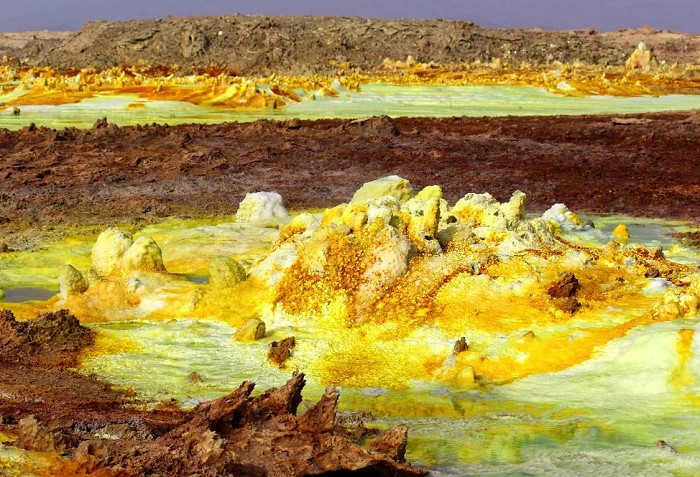
The original composition of the Earth’s atmosphere was vastly different from what it is today. In the early stages, the atmosphere consisted of a mixture of gases and vapors expelled by ancient volcanoes. These included water vapor, as well as hydrochloric, boric, and hydrofluoric acids.
At that time, the Earth’s gravitational forces were already strong enough to retain the atmospheric gases, giving rise to the primary atmosphere.
However, it is important to note that this primary atmosphere differed significantly from the atmosphere we have today.
Ancient volcanoes emitted clouds of gases. The lighter ones (hydrogen and helium) ascended to outer space, while the heavier ones remained near the surface of the planet due to Earth’s gravitational pull. It was from these gases that the Earth’s original atmosphere formed approximately 4.3-3.8 billion years ago. Of course, the composition of the gases exhaled by the volcanoes was vastly different from the nitrogen-oxygen atmosphere we have today. The early planet was surrounded by clouds of nitrogen, ammonia, carbon dioxide, methane, hydrogen, inert (noble) gases, as well as water vapor, hydrochloric acid, boric acid, and hydrofluoric acid. Oxygen, however, was scarce in the primary atmosphere and comprised less than 0.001% of the current concentration in the “air” of the ancient planet.
During that era, the majority of oxygen was trapped in different chemical compounds and did not exist in its free form. Moreover, the atmosphere was toxic and unfit for breathing, lacking the protective ozone layer that shields living organisms from cosmic radiation in the present day. Nonetheless, over time, it became enriched with the byproducts of meteorite combustion.
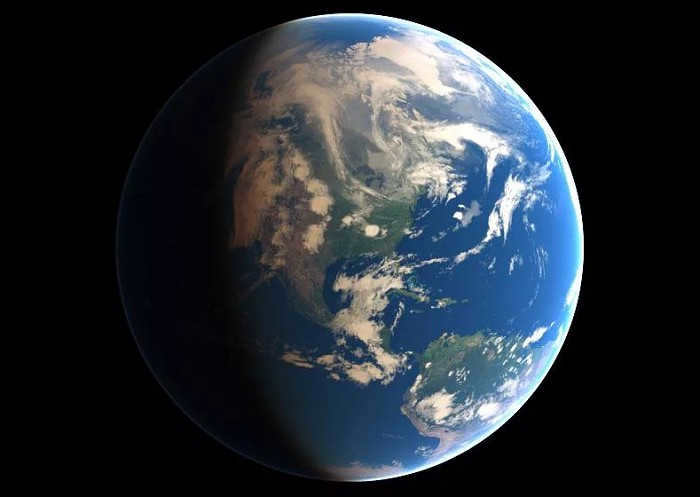
The composition of the current Earth’s atmosphere is vastly different from that of the ancient times. The predominant gases in today’s atmosphere are nitrogen, which makes up about three quarters of its volume, followed by oxygen, which accounts for approximately one fifth. Additionally, the noble gas argon is present in small quantities, making up around 1/100 of the atmosphere. In comparison to the past, the levels of carbon dioxide and water vapor are significantly lower, and other volatile elements can only be found in trace amounts, as chemists would describe them.
The gradual cooling of the Earth and the formation of the primary atmosphere played a crucial role in the emergence of the hydrosphere, which is the water shell surrounding our planet. In the early days, the atmosphere contained a significant amount of water vapor, which was released from the Earth’s interior along with molten lava. As this vapor condensed, it fell back to the surface in the form of rain. The water streams then gathered on the land, merging together and filling the low-lying areas, thus giving birth to the oldest lakes. However, the Earth’s surface was still extremely hot at this time, causing the liquid to boil and creating columns of vapor that rose back into the atmosphere. This continuous circulation of water helped to cool down the planet’s surface. As time went on, these lakes gradually expanded, eventually transforming into vast oceans. Along with the expansion of the water bodies, new streams brought along rock particles, weathered materials, and dissolved substances from the Earth’s surface. These dissolved substances included a mixture of salts, which is why seawater possesses its distinct taste, just as we experience it today.
It should come as no surprise that water initially appeared on Earth as vapor, accompanying the eruption of molten magma from the cracks in the crust. Currently, the amount of water trapped in the Earth’s mantle is so significant that it surpasses the combined volume of all the planet’s oceans and seas.
The proposed explanation for the formation of the primary atmosphere and hydrosphere appears logical and consistent. However, it is important to note that scientists have not directly witnessed these processes that occurred around 4 billion years ago. Instead, hypotheses have been formed based on indirect evidence. Many contradictions and mysteries still remain, and our understanding of Earth’s early evolution is limited.
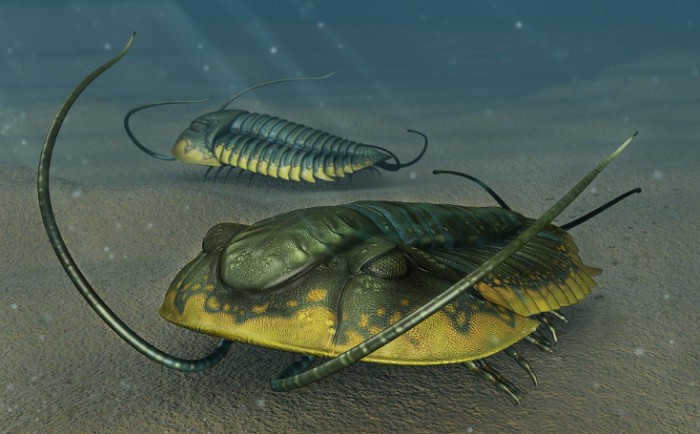
At first, life on Earth had quite peculiar shapes. Fish had not yet appeared, but there were grotesque many-legged worms and trilobites covered in shells under the water.
Earth stands out among the planets in the solar system due to its well-developed hydrosphere. Our planet contains such a vast amount of water that it covers approximately two-thirds of its surface, forming the world’s oceans. The outer crust, the Earth’s surface, the lower atmosphere, and the hydrosphere are sometimes collectively referred to as the geographical (landscape) envelope.
The age of our Sun is approximately 4.6 billion years. Upon its formation, it was surrounded by numerous tiny particles of matter that were remnants from distant stars’ demise. These particles were the building blocks for the future planets. For millions of years, they orbited around the youthful Sun, held together by the force of gravity, colliding and sticking together to create protoplanetary aggregates known as planetesimals. Subsequently, the largest among them started attracting smaller counterparts, gradually growing in size.
Astronomers hypothesize that Jupiter and Saturn underwent migration throughout the solar system after their formation, akin to balls in a bowling alley, displacing everything in their path. It is possible that Earth and Venus were initially occupied by other planets, referred to as super-Earths by scientists, but these planets either perished or were expelled from their orbits.
– The key idea is that the movements of Jupiter and Saturn led to the super-Earths being pulled towards the Sun. It is possible that some of them were pushed to the outer regions of the solar system due to gravitational forces. Presently, it is hypothesized that the enigmatic ninth planet could be one of these super-Earths. As a result of the material left behind, small planets similar to Earth were formed: Mercury, Venus, Earth, and Mars – Vladimir Surdin, a senior researcher at the P.K. Sternberg State Astronomical Institute.
How the Moon Came to Be and Why It’s Drifting Away from Us
The Earth, our home, came into existence in a remarkably short span of 10-20 million years, which is practically a blink of an eye in the vastness of the cosmos. During its early stages, a significant event took place: the Earth found itself accompanied by a steadfast companion, the Moon. The origin of this celestial partnership has been the subject of various theories.
– One theory posits that the Moon originated independently before being captured by our planet’s gravitational pull and has remained in its orbit ever since. Another idea suggests that the Earth and the Moon were both formed from the same gas and dust cloud, making them twin components of a double planet. The third hypothesis, which is strongly supported by current evidence, proposes that the Moon formed later than the Earth, in close proximity to it, as a result of a powerful collision with another small planet. This collision caused the crust and upper mantle of the Earth to be ejected and scattered around the planet, resembling Saturn’s disk, ultimately forming the Moon,” Vladimir Surdin.
According to calculations, it is estimated that around three billion years ago, the Moon was in such close proximity to the Earth that the tides reached extraordinary heights, potentially resulting in the transportation of living organisms to land as they were propelled far beyond the sea.
Gradually over time, our satellite has been gradually drifting away from Earth and into space.
– This phenomenon will inevitably lead to a deceleration in the Earth’s rotation. In fact, approximately half a billion years ago, a single day lasted approximately 18 hours. Presently, a day spans 24 hours. And if all progresses as expected, in several billion years, a day on Earth will extend to 54 modern days,” explains Vladimir Surdin.
A vast expanse of molten rock
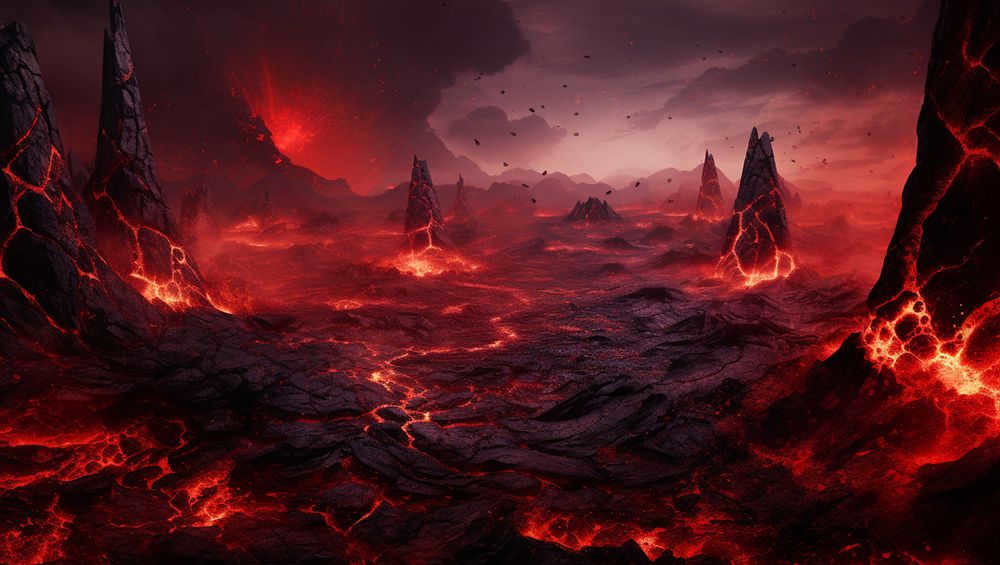
In its early stages, the Earth was enveloped by a vast ocean, although it was not composed of water, but rather of scorching lava. Approximately 4.5 billion years ago, after the process of accretion – the coming together of various materials – came to a close, the next phase commenced – the differentiation of these materials, which involved their separation based on physical properties. This transformative process lasted a mere 100 million years and was accompanied by intense melting. As a result, the planet’s iron core, its still unstable surface, and its primary atmosphere all took shape.
During the initial 500 million years of the Earth’s formation, there were rapid processes involved in the creation of the Earth’s crust. However, once this phase of melting came to an end, the planet underwent a relatively quick cooling process, considering cosmic time scales. This marked the beginning of the Earth’s geological history. The following brief video provides a simulation of what the Earth looked like in the past 100 million years. Each frame represents a million years.
Currently, scientists are discovering rock samples in various parts of the world, such as Australia, North America, and Africa, that date back more than 4 billion years.
Previously, it was believed that during its first billion years, the Earth was completely covered in molten lava that was extremely hot.
However, recent findings have revealed that heat generated by radioactive decay within the Earth’s interior played a significant role, but did not lead to extreme surface temperatures.
Recently, a diamond was discovered in Yakutia that dates back 3.6 billion years, making it the oldest diamond in the world.
The Origins of Earth’s Oceans and Continents
But where did the water on Earth come from? One theory suggests that water was brought to our planet by comets that bombarded it during its early stages. Another theory proposes that water has always been present on Earth. In space, there is a significant amount of water in various states, and it is believed that it was part of the accretion disk from which the planets of the solar system formed.
Even prior to the emergence of the Earth’s World Ocean, a solid shell known as the lithosphere was already in place. This lithosphere consists of the oceanic crust, which is primarily composed of basaltic rocks, and the continental crust, which formed through the “melting” of the oceanic crust and is predominantly composed of granitic rocks.
The initial continents on the planet did not instantaneously reach their current size. Instead, they formed from small patches of land that protruded as the surface cooled. Subsequently, these microcontinents collided and merged together. The oceanic crust continues to undergo active renewal, with the oldest portions being no more than 160 million years old. Conversely, fragments of the ancient Earth’s crust still persist within the continental landmass.
The Earth’s crust is diverse: the surface of the entire planet is composed of lithospheric plates that are constantly in motion. The initial supercontinent likely emerged approximately 2.9 billion years ago. Multiple times throughout the planet’s history, the continents have come together and separated. Presently, the Atlantic Ocean is still expanding, and in several hundred million years, the Pacific Ocean will vanish, and all the current continents will diminish into another massive landmass.
The magnetic field acts as a shield for the atmosphere and sustains life
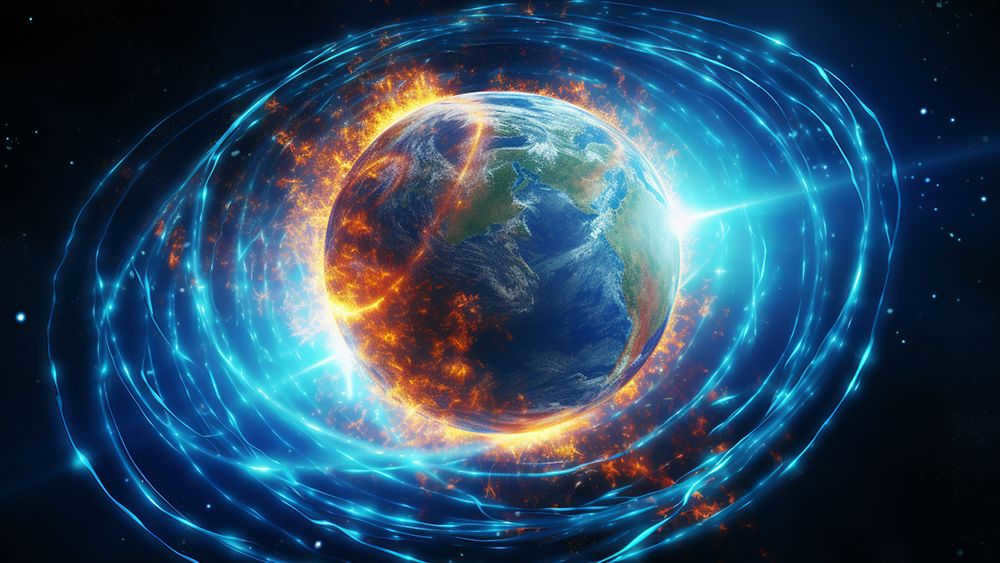
As our planet became enriched with greenhouse gases, its atmosphere also became enriched. The gases condensed and precipitated onto the Earth as intense rainfall, further establishing the dominance of water over land. However, one may wonder why these greenhouse gases did not escape into space.
– During the first billion years of our planet’s existence, it developed a robust magnetic field. This magnetic field acts as a shield, protecting us from solar wind streams. We can observe a modern-day example of this phenomenon on Mars. Mars, which lost its magnetic field long ago, had its atmosphere carried away by the solar wind,” explains Vladimir Surdin.
However, the origins of these resilient microorganisms remain a mystery. There are multiple hypotheses to consider. First, it is possible that life spontaneously arose on Earth, as it appears to be incredibly well-suited to our planet’s conditions. Another possibility is that life was brought to Earth from outer space, potentially from Mars or Venus (although the question of how it arrived there remains unanswered). This theory is known as “panspermia.” Yet, the most widely accepted hypothesis currently is “soft panspermia,” which suggests that the essential building blocks of life were transported to our young planet from space in the form of organic substances that are abundant in the cosmos. Once here, these substances found themselves in unique conditions and gave rise to the first forms of life. The search for extraterrestrial life is discussed further in the article.
By the way, it is worth mentioning that Earth’s bacteria have been known to travel into space, potentially leading to the possibility of life originating on other planets. This is yet another theory to consider.
The initial living organisms nearly caused their own demise
In one way or another, the first living organisms initiated the process of evolution, ultimately giving rise to all present-day species, including humans. Interestingly, it was the initial widespread microbes, known as cyanobacteria, that are responsible for the Earth’s modern atmosphere, which emerged around 2.5-3 billion years ago. Cyanobacteria essentially “inhaled” carbon dioxide and converted it into oxygen through photosynthesis, thanks to their unique ability to harness sunlight. However, since oxygen was a deadly toxin for the first organisms, it nearly resulted in catastrophe – the microbes came close to poisoning themselves.
By the way, one theory suggests that plants were responsible for triggering the initial global climate change. Through their absorption of carbon dioxide, they actually decreased the greenhouse effect, potentially leading to the first ever global cooling. In addition, the continents’ growth increased the Earth’s reflectivity, further contributing to this phenomenon. As a result, the planet transformed into a “snowball”, completely covered in ice for a certain period of time.
It is difficult to determine the exact number of these cold periods or when the first glaciation occurred, but scientists are confident that there were multiple instances throughout Earth’s history.
The rise of intricate organisms and the colonization of terrestrial habitats

Ever since their initial appearance, the microorganisms that reside on Earth have continually adjusted to evolving circumstances. Certain unicellular organisms developed the ability to aggregate, thus aiding one another in their quest for survival. Consequently, this marked the emergence of the earliest multicellular organisms. By approximately 600 million years ago, the planet was already inhabited by intricate life forms. Then, around 570-580 million years ago, the Cambrian explosion occurred, signifying an unparalleled surge in animal diversity.
The presence of a strong skeletal structure allowed animals to develop various adaptations such as teeth, claws, shells, and exoskeletons. The diverse aquatic animal world sought to expand its habitats and explore new environments, including land. This transition to land began around 400 million years ago. The first pioneers to venture onto land were algae, which eventually evolved into all land plants. As food resources became abundant on land, animals followed suit and started migrating to this new frontier.
– Firstly, it is important to note that they were arthropods, specifically chelicerae, with scorpions being a prime example. Initially, scorpions inhabited aquatic environments before gradually transitioning to life on land. Additionally, fish, following in the footsteps of arthropods, also made their way onto land. The initial adaptation to terrestrial life can be observed in bipedal and keystepper fishes. Furthermore, bivalves possess the ability to respire through both gills and lungs. Kysteperiformes, on the other hand, utilized their sturdy fins as a means of support while navigating shallow water or even traversing land surfaces, – Sergey Naugolnykh.
Is the human species intelligent?
Around 250 million years ago, the Earth was already home to reptiles – the ancient ancestors of today’s crocodiles and turtles. Following them, the first ancestors of modern mammals started to emerge, known as reptile-like mammals.
– It is now widely accepted that these creatures had fur. It is believed that some, if not most, were warm-blooded. This was a significant step towards the evolution of the first true mammals,” says Sergei Naugolnykh.
< p > Mammals emerged after reptiles and were outcompeted by the dominant dinosaur fauna, which ruled the land, air, and water for nearly 170 million years. However, these colossal reptiles eventually met their demise, possibly due to an asteroid impact around 66 million years ago. Some scientists argue that ecosystems were already struggling prior to the impact. Interestingly, birds, which are descendants of dinosaurs, managed to survive and thrive. The extinction of the dinosaurs paved the way for the rapid evolution of our ancient mammalian ancestors. < / p >
History could have taken a different course, but unfortunately, it went a different way and as a result, certain species died out. Approximately 30 million years ago, a new group of animals known as great apes emerged on our planet. These great apes eventually gave rise to gibbons, orangutans, chimpanzees, gorillas, and humans. It is interesting to note that our immediate ancestors, known as Australopithecus, were essentially apes but they began to walk upright about 7 million years ago. This was a significant development in our evolutionary journey.
About 2 million years ago, another group of primates called Homo entered the historical stage. These primates had the ability to create and use tools, marking a crucial advancement in their cognitive abilities. Finally, our species, intelligent man, emerged a mere 300,000 years ago. It is truly remarkable to think about how recent our existence is in the grand timeline of Earth’s history. In fact, written history, as we know it, only dates back about 5,500 years.
When we consider the vast timescale of Earth’s history, human civilization is but a fleeting moment. However, it is during this brief period that our species has the potential to drive some of the most significant changes on the planet. We have the power to shape the future of our world.
Our understanding of Earth’s evolution is constantly evolving as new studies and research emerge. We have gathered the most up-to-date information that will deepen your knowledge about the formation of our planet.
Read “Hitech” at
How did the Earth come into existence?
The Earth came into existence approximately 4.567 billion years ago through the process of accretion from the protoplanetary disk. This disk-shaped mass of gas and dust was left over from the Sun’s formation and eventually gave rise to our solar system. The primary atmosphere was formed through volcanic degassing, but it lacked oxygen and would have been harmful to humans and modern life.
A large portion of the Earth was molten as a result of active volcanism and frequent collisions with other celestial bodies. It is believed that one of these significant collisions caused the Earth’s axis to tilt and led to the formation of the Moon.
Over time, the intense bombardment from cosmic objects ceased, allowing the planet to cool down and develop a solid crust. Water that was brought to the planet by comets and asteroids condensed into clouds and oceans. As a result, the Earth eventually became a suitable environment for life, and the earliest life forms played a crucial role in enriching the atmosphere with oxygen.
The Formation of the First Continents
Geophysicists have made a fascinating discovery regarding the Earth’s crust approximately 3 billion years ago. They found that there was a significant expansion in the crust, indicating a period of rapid growth. Scientists speculate that only 1.5 billion years after the formation of the Earth, the mantle, a layer of silicate rock located between the crust and the outer core, experienced a substantial increase in temperature. This resulted in the seepage of magma into fragments of older crust, which ultimately served as the foundation for the development of the modern continents.
It is likely that there were multiple occurrences in Earth’s past when the outer layer of the planet was created. However, the massive injection that took place approximately 3 million years ago stands out as one of the most significant events.
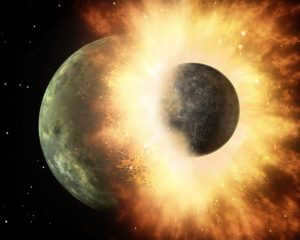
What was lost during the process of Earth’s formation?
A team of scientists has developed a unique model to study the radioactivity of ancient rocks on Earth. This model challenges existing theories about the formation of continental crust and proposes that continents emerged from the ocean much earlier than previously believed. However, these ancient continents were eventually destroyed, leaving no trace behind.
Researchers from the University of Adelaide have conducted two studies using this new model to analyze the radioactivity of rocks over billions of years. Their findings indicate that Earth’s continental crust may have been thicker and formed much earlier than current models suggest, suggesting the presence of continents as early as four billion years ago.
If our hypothesis proves to be accurate, it could necessitate the reassessment of numerous aspects of our comprehension of the chemical and physical evolution of the Earth, including the pace of continental expansion and conceivably even the initiation of plate tectonics.
Research Text
Dr. Hasterock and his graduate student Matthew Gard amassed 75,800 samples of geochemical composition from igneous rocks (such as granite) that are believed to have originated alongside the initial landmasses. They approximated the current radioactivity levels in these rocks and formulated a model of the average radioactivity from 4 billion years ago until the present day.
The scientists elucidate that all rocks contain inherent radioactivity which generates heat and raises the temperature within the Earth’s crust. Over time, this radioactivity decays, with rocks possessing higher levels of radioactivity producing more heat.
Continental rocks are typically more radioactive than oceanic rocks. If a rock is 4 billion years old, it would have approximately four times the amount of radioactivity compared to present-day rocks.
However, the researchers discovered an unexpected decrease in radioactivity levels in rocks older than 2 billion years. Once they accounted for the higher heat production caused by the presumed higher radioactivity, the deficit vanished.
Scientists speculate that this could be due to the combination of high radioactivity and high temperatures, causing the rocks to either melt or be easily destroyed by tectonic activity.
According to current theories, the continents arose from the oceans as the Earth’s crust thickened. Nevertheless, the authors propose that there may have been a significant amount of continental crust much earlier, despite its instability.
A recent research conducted at the University of Texas at Austin has revealed a potential connection between life on Earth and the movement of continents. The findings validate the notion that sediments, which often contain remnants of deceased organisms, can potentially exert a significant influence on the pace of continental drift.
The study elucidates how sediment, either moving beneath or subducting beneath tectonic plates, can regulate the movement of these plates and even impact the rapid formation of mountain ranges and the growth of continental crust.
Sediment is formed through the erosion of pre-existing rocks by wind, water, and ice, or through the accumulation of shells and skeletons of microscopic organisms like plankton on the ocean floor.
For a long time, it has been recognized that sediments trapped in subduction zones have an impact on geological activity, such as the frequency of earthquakes. However, it was previously believed that they had little influence on the movement of continents. This is because the rate of subduction is determined by the strength of the subduction plate.
The movement of continents is caused by one plate submerging beneath another, so the force exerted by the part of the plate that sinks into the Earth’s mantle (and the energy required to bend it) determines its speed of movement, with sediment having minimal effect.
Nevertheless, early research conducted by UTIG scientists has revealed that subduction plates may be weaker and more responsive to other factors than previously assumed. As a result, the researchers set out to explore other mechanisms that could potentially influence plate velocity.
Researchers have assessed the potential impact of different rock types on the plate interface, which is the area where subductive plates converge. Subsequent simulations have revealed that sedimentary rock could have a lubricating effect on the plates, resulting in an acceleration of subduction and an increase in plate velocity.
This process can trigger a complex feedback loop. As the velocity of the plates intensifies, there will be less time for sediment to accumulate, leading to a decrease in the amount of subducted sediment.
Consequently, subduction slows down, enabling the growth of mountains at plate boundaries due to the collision between the two plates causing uplift. As a result, the erosion of these mountains by wind, water, and other forces generates additional sediment that returns to the subduction zone and restarts the cycle, thereby enhancing the rate of subduction.
For more information, please click here.
4.5 billion years ago, our planet came into existence when a cloud of gas and dust known as a protoplanetary disk condensed. Over time, the Earth cooled down and developed its crust, oceans, and atmosphere. Changes in the mantle’s convective regimes also occurred. The outlines of the land shifted due to plate tectonics, leading to the formation and breakup of supercontinents. By analyzing the chemical composition of rocks and using radioisotope dating, modern geological research has allowed us to understand the characteristics of these processes. It has been discovered that the planet’s continuous exponential cooling has resulted in global geological events occurring with a distinct periodicity. At least four ancient supercontinents have been identified so far, each forming at roughly equal intervals of time.
The evolution of our planet – from a young celestial body formed from the swirling gas and dust cloud around the Sun to its current state – has undergone several significant stages. The primary factor driving alterations in the internal and external appearance of Earth is its ongoing cooling process following the formation of 99.9% of its mass, along with the gradual oxidation of its surface and near-surface layers (such as the crust, hydrosphere, and atmosphere). Valuable insights into these changes can be gleaned by comparing endogenous and near-surface processes and phenomena, as well as by analyzing geological data, including the composition of various elements in the crust and core, the radioisotopic makeup of rocks, and the findings of paleomagnetic studies.
From One Supercontinent to Another
According to modern astrophysical data, the Earth’s formation took place through a process known as hot accretion. This involved the heating of the young planet due to the impact of planetary embryos and the decay of short-lived isotopes, resulting in high temperatures. Over time, the Earth gradually cooled down, leading to a decrease in the average heat flux and mantle temperature. Currently, the temperature at the boundary between the upper and lower mantles is around 2000-2100 °C, whereas during the late Archean – early Proterozoic era (2.6-2.7 billion years ago), it reached as high as 2400 °C. Eventually, this excess heat was radiated out into space, causing a decrease in thermal energy within the Earth’s subsurface.
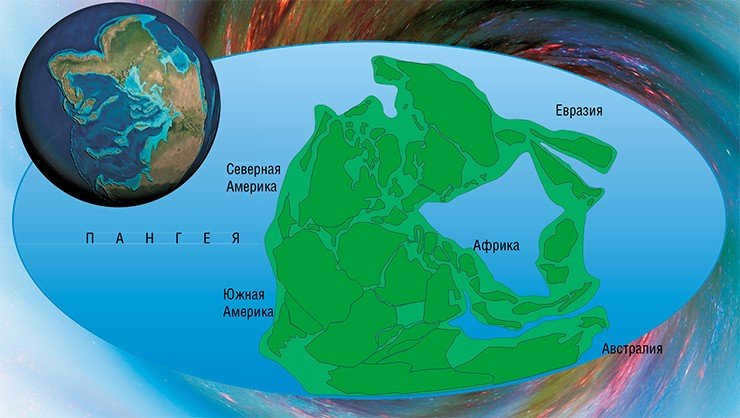
Scientific evidence from the chemical composition of rocks originating from deep within the Earth supports the hypothesis that supercontinents were formed as a result of convective processes in the mantle. The data obtained from analyzing the strontium isotope content in carbonate sediments, as well as the potassium content in granites and arkosic sandstones, demonstrate an increase in these elements between 3000 and 2000-1700 Ma, followed by periodic fluctuations. The peaks in the 87 Sr/ 86 Sr and K2O/Na2O ratios, along with the isotopic dating of major crust-forming rocks, align with the ages of the supercontinents (Condie, 2005).
The Earth underwent a reorganization of convection patterns in its mantle due to continuous cooling. What is remarkable is that the gradual decrease in heat flow from the interior resulted in a clear periodicity in the formation of supercontinents, leading to periodic changes in convection as well.
Initially, the Moon did not exist alongside the Earth…
The Earth’s history as a celestial body commenced approximately 4.55-4.44 billion years ago. The length of time it took for the Earth’s iron core to grow and separate was heavily influenced by the dynamic viscosity of the mantle, which underwent significant changes during the accretion process, potentially varying by two or three orders of magnitude. Consequently, estimates of this stage’s duration differ widely, ranging from 10 million years to 1 billion years. By examining the hafnium and tungsten content in terrestrial and lunar rocks, scientists have been able to refine the timeline, revealing that the Earth’s core formed almost simultaneously with the planet’s growth within the first 30-50 million years of its existence.

According to an alternate theory, it is possible that the Moon formed through a series of smaller impacts from bodies of similar size. Under this model, the Earth may have had a small magma ocean (less than 300 km in size). However, in this scenario, as well as in the case of a single large impact, it is challenging to explain how the ejected material was preserved in the Earth’s orbit and how the Moon subsequently formed from it.
Ultimately, the hypothesis of the Earth and the Moon forming simultaneously as a double planet is supported by significant evidence from both geochemistry and cosmochemistry.
All three of these hypotheses vary in the extent to which they could disturb the Earth’s condition. The megaimpact has the potential to cause significant disruptions in the mantle’s composition, leading to a high degree of differentiation in the Earth’s internal structure and temperature. In contrast, the hypothesis of the simultaneous formation of the Earth and the Moon assumes that the processes of internal evolution of both celestial bodies proceeded without disturbance.
HAFNIUM AND TUNGSTEN – TIME STAMPS
To determine the age of the Earth’s metallic core formation, scientists study the presence of the radioactive isotope 182 Hf and its decay product 182 W in geological rocks. These elements are both refractory and were originally present in the same proportion before the core separation. As hafnium-182 decays over time, the ratio of tungsten-182 to other stable tungsten isotopes, such as 184 W, increases.
During the extraction of iron from the rocks that make up the Earth, most of the iron-soluble siderophilic tungsten goes into the core, while lithophilic hafnium remains in the silicate layer. As a result, the 182 W/ 184 W ratio in the silicate layer will be greater than in the original mixture, and its value depends on the amount of hafnium that has not yet decayed when tungsten leaches into the core. By comparing the ratio of tungsten isotopes in the Earth’s crust with their content in chondrites, meteoric bodies that formed in the protoplanetary disk before the Earth’s formation, scientists can determine the age difference between chondrites and ancient rocks and thus date the time of core formation (Wood, 2011).
At the end of the accretion phase, a hot atmosphere composed primarily of hydrogen and methane was formed, largely due to the descent of comets. In terms of water, its mass could range from 2 to 10 times that of the current hydrosphere. However, around 4.4 billion years ago, the early atmosphere was lost as hydrogen dissipated into space and oxidation began. This process of oxidation affected not only the atmosphere, but also the Earth’s surface, crust, and upper mantle in the following stages.
Hadei – a youthful planet with lifeless oceans
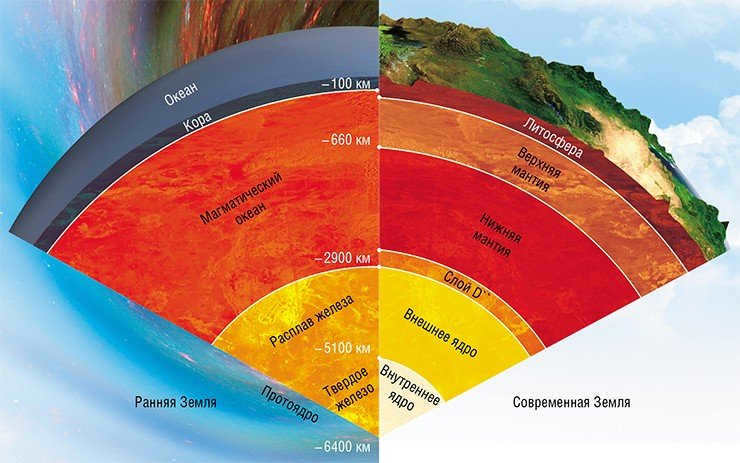
The duration and depth of the magma ocean, as mentioned above, are dependent on the Moon’s formation process and the intensity of meteorite impacts, and can vary significantly. However, it is highly unlikely for a magma ocean to exist after 4.0 billion years. Nonetheless, according to B. C. Shkodzinsky (2009), the formation of a magma ocean up to 1000 km thick is considered a significant event in Earth’s history, and remnants of this ocean may have persisted for a considerable period of time (refer to V. C. Shkodzinsky’s article in this journal issue, page 12).
The Frontier of Diamonds
During the Archean era, which occurred between 3.9 and 2.7 billion years ago, there was a continued cooling of the Earth’s mantle and core. This resulted in the formation of the Earth’s inner core and a significant increase in the strength of the magnetic field, which was approximately 1.5 to 2 times stronger than before. The cooling of the upper layers of the Earth’s crust led to the formation of a large number of diamonds, with around 90% of ancient diamonds being formed between 3.2 and 2.9 billion years ago by kimberlites. This can be attributed to the thickening of the lithosphere, which in turn increased the pressure within the solid interior due to the weight of the rocks. By the middle of the Archean era, the thickness of the lithosphere (which includes the crust and solid mantle) exceeded 100 km, whereas prior to this time, it was only about 50 km thick or less. This is approximately the same thickness as the modern oceanic lithosphere. Additionally, there was a significant oxidation of the mantle during this time, resulting in the appearance of carbonatites and solutions enriched with carbon dioxide. These reacted with methane, ultimately releasing carbon, which then formed diamonds. Therefore, the presence of diamonds can serve as an important indicator of changes in the thermal regime and mantle oxidation, making the “diamond frontier” a significant phenomenon.
In general, by the end of the Archaean, approximately 20% to 50% of the continental crust’s volume had been created.
Transitioning from ‘small plate tectonics’ to ‘plume tectonics’ and the formation of supercontinents
The boundary between the Archaean and Proterozoic eras, which occurred approximately 2.6-2.7 billion years ago, marks a significant period of increased granite and alkaline crustal rock formation. It is possible that during this time, the first supercontinent began to form, although there is limited geological and paleomagnetic evidence to confirm its shape and even its existence. Prior to this period, the convection mode in the Earth’s mantle was likely turbulent, and “small plate tectonics” dominated. Some researchers suggest that throughout the Archaean era, the mantle had a bilayer convection regime, while others propose a more chaotic (highly turbulent) convection regime that encompassed the entire mantle.
Regardless, around 2.6-2.7 billion years ago, there was a change in the convection regime within the mantle, leading to the aforementioned effects and other significant changes.
As a result of the change in convection regimes, superplumes emerged in the mantle and initiated a phenomenon known as “plume tectonics”. This event marks the first peak in the ages of mantle rocks. It is possible that the regime of bilayer convection in the upper and lower mantle, if it existed prior to this transition, remained intact. However, it was disrupted by the emergence of large jets of rising superplumes and the sinking of melting crust from subduction zones into the core. Geochemical evidence suggests that the magmatic reservoirs of the upper and lower mantle became isolated once again around 2.0-1.8 billion years ago.
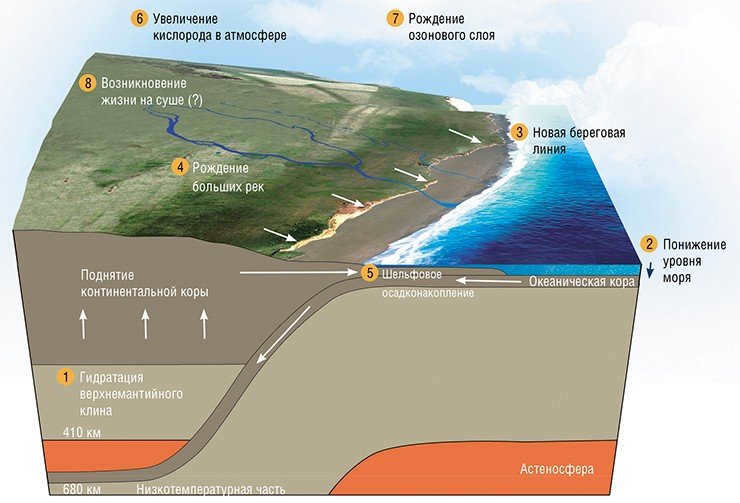
The period 1.7-0.7 billion years ago was marked by a decrease in internal activity of the Earth. During this time, there was a restructuring of mantle currents, transitioning from general mantle convection to bilayer convection, and a decrease in plume activity. Additionally, this period saw the formation and breakup of the third supercontinent, known as Rodinia (derived from the Russian word for “to give birth”).
“Dead Earth” brought life into existence
The time period around 750 million years ago holds special significance. Prior to the billion year mark, all metamorphic rocks found indicate relatively low pressure during their formation. This suggests that they were formed at a depth of approximately 40-60 km. The rocks dating back 750 million years, however, require higher pressure for their formation. This indicates that they were formed at a greater depth of 150-200 km, or in other words, at a lower temperature at the same depth. For instance, at a depth of 100 km, the temperature could have dropped from 1000 to 400-600 °C.
This scenario is only possible if the rate of subduction (the sinking of crust into the mantle) significantly increased and reached or surpassed the maximum subduction rate observed today (around 10 cm/yr).
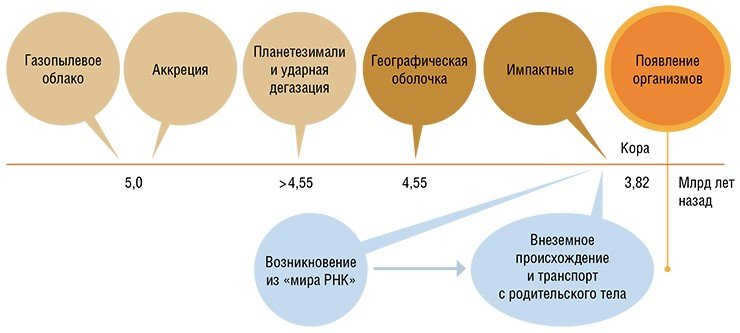
Photosynthesis was responsible for an elevation in the oxygen levels in the atmosphere, resulting in the formation of an ozone layer that shields the Earth’s surface from harmful ultraviolet radiation. Furthermore, this process played a crucial role in creating the necessary conditions for life to thrive on land.
The events mentioned above were preceded by a decline in the Earth’s internal activity. Some researchers (Sh. Maruyama et al.) refer to this period as the “Dead Earth”, which is characterized by the rearrangement of convection currents and mantle plumes. The changes in mantle currents resulted in a cooling of the Earth’s surface, leading to frequent and large glaciations between 750-600 million years ago, with the largest possibly occurring around 640 million years ago. During this period, the Earth was often described as a “snowball Earth” due to its frozen state resembling a snowball. The initial hypotheses regarding this state were based on geochemical data and paleomagnetic determinations of glacial deposits, some of which were found near the paleoequator. However, there are still many uncertainties and contradictions, making this scenario of global glaciations one of several possible explanations.
Between 750-600 Ma, there was a strengthening of subduction that led to a surge in island-arc magmatism and the occurrence of large volcanic eruptions. This event also resulted in a significant but fluctuating release of CO2 into the atmosphere, which contributed to climate warming through additional oxidation. From 600 Ma onwards, the endogenous systems, climate, and biosphere have undergone changes that resemble the scenarios observed in the present day.
Therefore, the ongoing cooling and oxidation of our planet resulted in a myriad of different phenomena. The convective patterns within the Earth’s mantle underwent transformations, leading to the formation and breakup of supercontinents. The lithosphere and crust gradually thickened, while the surface cooled down, giving rise to the formation of seas and subsequently, sedimentary rocks. Moreover, the solidified crust descended into the mantle through subduction zones, causing the continents to rise above it. Over time, the geological nature of the Earth became increasingly stable, resulting in a decrease in the average surface temperature and the emergence of favorable conditions for the existence and evolution of various life forms.
Dobretsov N. L. Fundamentals of tectonics and geodynamics / textbook / Novosibirsk: NSU, 2011.
Wood B. The formation and differentiation of Earth // Physics Today. December 2011. P 40-45.
The textbook “Fundamentals of Tectonics and Geodynamics” by Nikolai Leontievich Dobretsov was originally designed to serve as a contemporary educational resource for undergraduate geology students taking the tectonics and geodynamics course at NSU’s Geology and Geophysics Department. However, due to the extensive and in-depth coverage of the topics, it is undoubtedly valuable and captivating not only for undergraduate and graduate students specializing in geology, but also for professionals in other fields of study related to the Earth’s evolution.
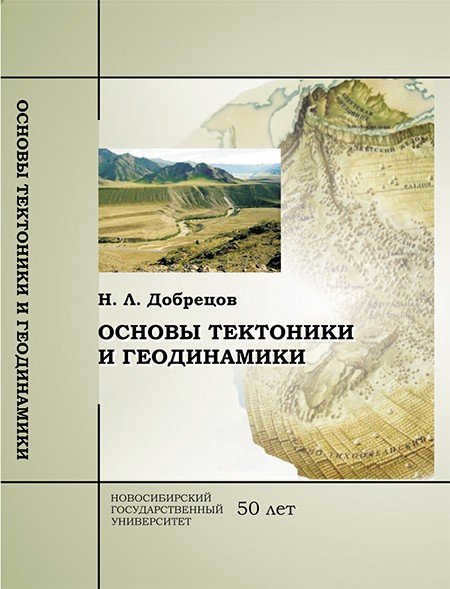
The Laboratory of Petrology and Ore-bearing Magmatic Formations at the Institute of Geology and Mineralogy is headed by Professor A. E. Izokh, who holds a Doctorate in Geological and Mineralogical Sciences.
On June 26, 2012, an article titled “Recipes of the Creation of the World” was published in Volume 44, Issue 2.
Current research methods have provided us with an estimate that our planet is approximately 4.5 billion years old. However, the origins of Earth and the processes that led to its formation are still largely based on theories and hypotheses. There is limited geological evidence available, and our understanding of planet formation in other galaxies is limited due to the relatively short period of observation.

Theories on the Origins of Planets
There is still much to learn about the early stages of planet formation, and as scientific knowledge advances, new theories arise to explain the creation of Earth. The first hypotheses on planet formation emerged in the 17th century; however, subsequent research has disproven many of them.
Currently, the prevailing belief among scientists is that Earth originated from dust and gases during the early formation of the solar system. Nevertheless, earlier hypotheses cannot be entirely dismissed.
The Laplace’s Concept
Presented by P. S. Laplace in 1796, the hypothesis of planet formation proposed by Laplace was widely acknowledged by the scientific community due to its partial substantiation by mathematical calculations. According to this researcher, the solar system and its components were formed as a result of the primary nebula’s rotation.
During compression, the centrifugal force may surpass gravity in its growth rate, but once they reach equilibrium, rotational instability may occur, leading to the flattening of the nebula and the separation of dense matter from its core. Subsequently, the expelled gases and dust formed flat rings, which then coalesced under the increasing pull of gravity to give rise to planets.
Kant’s theory
Kant proposed an original hypothesis regarding the genesis of the solar system, asserting that the Earth and all its constituent elements, as well as the rest of the celestial bodies, were created from a combination of dust and gases. According to Kant, gravity played a vital role in this cosmogonic process. The formation of the Sun took place first at the center, followed by the subsequent emergence of the planets.
The theories proposed by Kant and Laplace have inherent flaws.
The hypotheses concerning the origins of the Earth, presented by Laplace and Kant, possess several deficiencies. Many contemporary astrophysicists are of the opinion that the primary nebula had such a low density that its rotation could not have occurred in the same manner as that of a solid object. This raises doubts about the influence of rotation on the formation of the central star and the surrounding planets.
In addition, it is implausible for matter to detach abruptly from the equatorial region of the formation. It is believed that this process must be continuous, akin to the formation of a nebula.
Some researchers argue that a ring with a mass equivalent to that of a planet would be incapable of condensing and subsequently dissipating under its own gravitational force. The Sun’s core emits substantial amounts of energy not through compression, but rather through thermonuclear fusion.
Fesenkov’s theory
V. G. Fesenkov proposed several theories regarding the origin of the Sun and the Earth. Initially, he posited that a star is initially formed with an extremely high temperature, but subsequently, as it cools down and attains a high rotational velocity, a gas mass separates from it, giving rise to the formation of a planet.
Later, V. G. Fesenkov put forward the idea that the formation of a planet could occur from a primary cold cloud composed of dust and gases. This process is preceded by a significant increase in the star’s rotational speed, resulting in the expulsion of matter and the densification of the gas-dust medium. The planet embryos exhibited a density of approximately 10 g/cm³.
Moulton and Chamberlin’s Theories
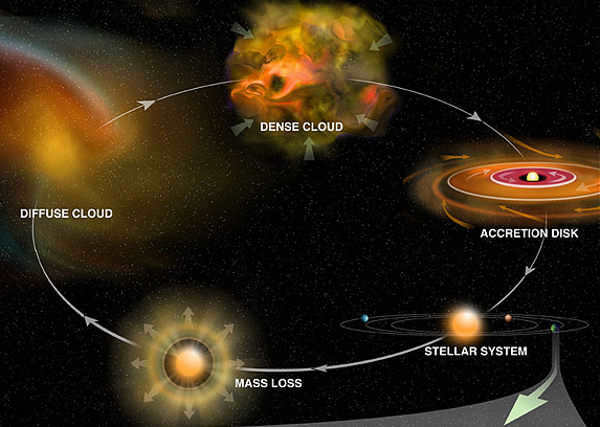
According to the theories proposed by geologist T. Chamberlin and astronomer F. Moulton, the Sun did not have any planets as satellites around 65-70 billion years ago. However, in the future, another star approached it.
Due to the gravitational force of this nearby star, a massive tidal wave of liquid and gaseous substances was formed. It followed the trajectory of the approaching star.
Over time, these detached masses were captured by the gravity of the Sun and held at a certain distance from it. Through the process of gas condensation, the elements combined with each other.
This led to the formation of small, dense bodies, which eventually evolved into planets, satellites, meteorites, and other celestial objects.
D. Jeans hypothesized that following the formation of the Sun, a neighboring star ventured near and gravitational forces caused a portion of matter to be drawn out. This resulting blend of gases underwent condensation, leading to the creation of initial small solid objects, eventually evolving into asteroids, planets, and more. Over time, these formed entities engaged in collisions until their orbits reached a state of stability.
Schmidt’s theory – a unique perspective
Renowned scientist O. J. Schmidt revolutionized our understanding of the Solar System with his groundbreaking hypothesis. According to Schmidt, the Sun took shape as the primary entity, surrounded by a swirling cloud composed of frozen gases and dusty particles. These celestial constituents, in constant motion, underwent a remarkable transformation. Through compaction, collision, and gravitational attraction, they gradually formed into a more condensed and flattened structure. Eventually, the solid components began to orbit in a circular trajectory, ultimately coalescing to give rise to the magnificent planets we know today.
The theories proposed by Rudnick and Sobotovich
In 1984, E. Sobotovich and V. Rudnik presented their theory regarding the formation of the Earth. According to their hypothesis, the initial state of our solar system was a gas-dust nebula. However, a significant event occurred that had a profound impact on this nebula. It is highly probable that this event was the result of a nearby supernova explosion.
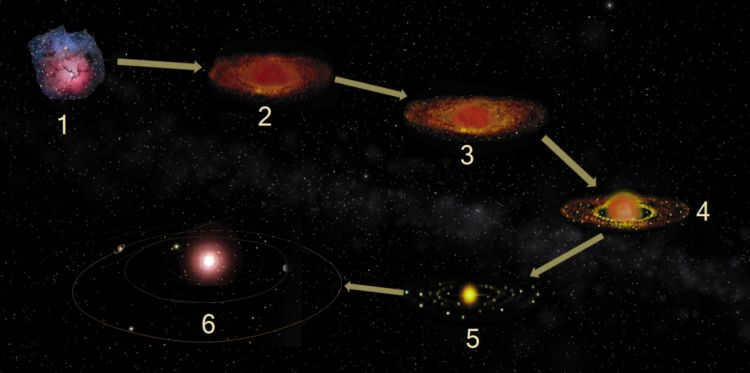
The compression of the nebula and the subsequent release of a significant amount of energy initiated the process of condensation, leading to the formation of the Sun at the center. This compression also resulted in the creation of rings composed of various elements such as dust, solid rocks, and gases. The combined forces of compression and gravity played a crucial role in the formation of not only the Earth but also other planets in our solar system.
According to some scientists, there is a school of thought that postulates the genesis of the universe as a result of a massive explosion, commonly known as the big bang. This cataclysmic event caused the original matter or plasma, which was characterized by an incredibly high temperature, to burst forth. Consequently, the matter and particles that managed to escape this explosion were propelled in various directions, albeit not evenly distributed.
Simultaneously, the temperature of the universe remained exceptionally high for an extended period, preventing the scattered particles from coalescing. Only when the temperature gradually decreased to 4000°C, did low-mass helium and hydrogen atoms start to form. As the universe continued to cool down, the emergence of heavier chemical elements became possible.
Following the process of cooling, the atoms came together to create initial gas and dust nebulae, which eventually formed various celestial bodies. Gravity played a crucial role in facilitating this process. Scientists estimate that the formation of galaxies took place approximately 1-2 billion years after the big bang event. The Sun, for instance, originated from one of these nebulae, followed by the formation of the planets.

The origin of the Earth from gaseous to solid state
In the beginning, the Sun was encircled by gases and tiny particles of dust. These particles moved in a disorderly manner, colliding and combining. Simultaneously, they were affected by the gravitational force of the Sun, as well as by the bodies and atoms that were separated from it. The compression of gases and dust contributed to the creation of rocks, meteors, and asteroids, and eventually, the formation of large solid entities like planets.
Formation of Planets
The Earth is not just a solid rock; it is a complex structure with multiple layers. As the planet’s volume increased, its core underwent compaction.
During the early stages of its formation, the young planet contained various radioactive substances, such as:
- Substance 1
- Substance 2
- Substance 3
The core’s nuclear reactions and the decay of isotopes caused the planet to melt. Consequently, its surface was once completely covered by a vast ocean of molten lava.
Volcanic activity intensified over millions of years, coinciding with the continuous bombardment of asteroids, comets, and meteors. These celestial objects delivered a variety of chemicals to the molten surface of the Earth.
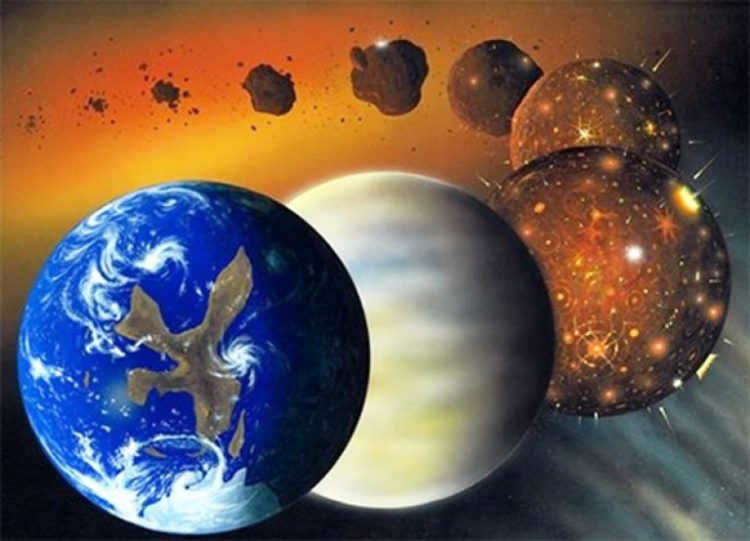
Over time, the Earth’s surface gradually underwent a cooling process, leading to the formation of the crust. However, approximately 30 million years after the Earth was fully formed, it experienced a collision with another celestial body known as Theia. This collision resulted in a significant release of energy.
As a result of the collision, the two planets merged and reverted to a liquid state. During this process, a considerable amount of debris was ejected into space. Under the influence of gravity, these debris eventually coalesced to form a ring, which later gave rise to the Moon.
The Earth was in a molten state for a significant period of time due to the process of radioactive decay. However, over time, volcanic activity decreased and the surface cooled, resulting in the formation of the Earth’s crust. This crust then began to accumulate water, giving rise to the primary world ocean. Although numerous volcanic islands initially dotted the ocean’s surface, they were eroded by the relentless action of the sea.
An increase in volcanic activity caused the crust to fracture, allowing water to seep into these fractures and giving rise to a new type of rock known as granite. This granite then served as the foundation for the formation of the continents as we know them today.
Continental movement
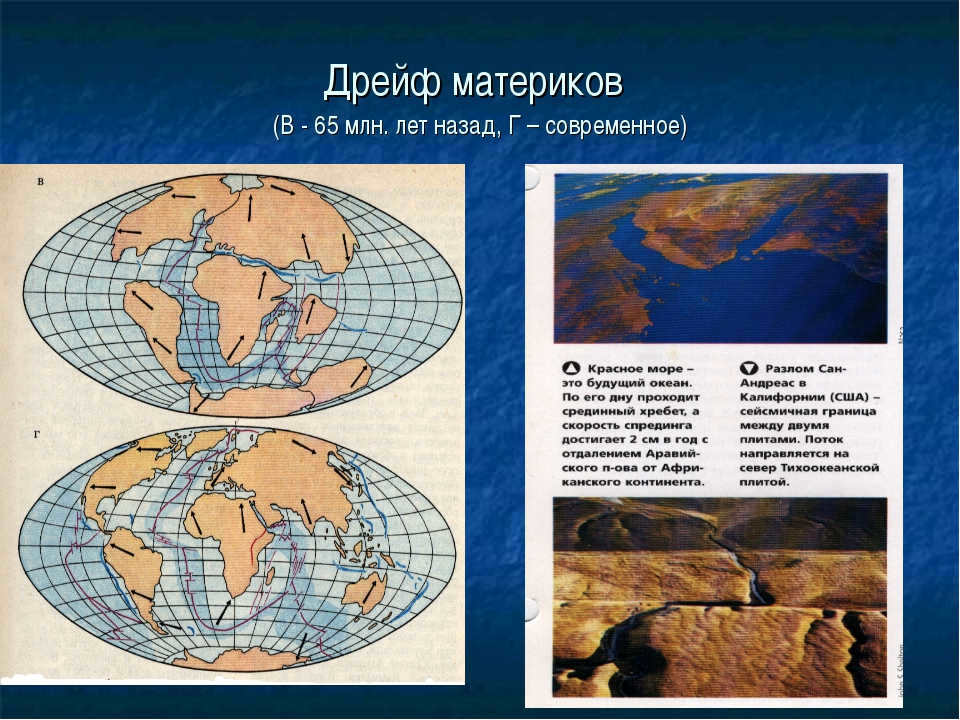
The formation of the first continents occurred approximately 3.5 billion years ago. These continents were composed of granite, a material that possessed resistance to water and possessed a lighter and less dense composition than the basalt that comprised the oceanic crust.
Due to the disparity in density and weight, the granitic continents were capable of undergoing drift across the Earth’s mantle.
Throughout the course of Earth’s development, these continents underwent repeated cycles of coalescing to form supercontinents and subsequently fragmenting due to the impact of the planet’s internal heat on them.
Life is believed to have originated during the formation of the initial landmasses. Active volcanic processes were occurring beneath the ocean. “Black smokers” discharged hot water containing a variety of trace elements. Additionally, amino acids and other compounds were deposited into the ocean through meteorites and asteroids.
The unique conditions led to the accidental emergence of the first single-celled microorganisms, which relied on the energy from underwater volcanoes.
The changing circumstances caused certain bacterial species to rise to the surface and evolve the ability to obtain food through photosynthesis. Extensive colonies of stromatolites formed in shallow waters near the newly formed landmasses. These algae produced significant amounts of oxygen. The increasing levels of oxygen in the water and atmosphere facilitated the development of multicellular organisms.

